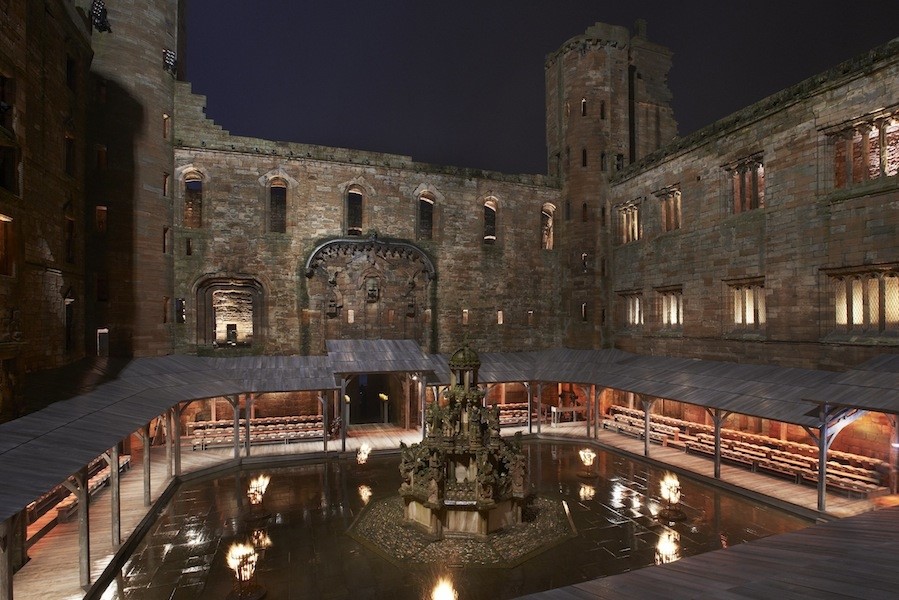Imagine a soon-to-become fabled fashion experience that conjured up breath-taking, thrilling and innovative. Last Tuesday, Chanel’s Karl Lagerfeld created precisely that when delivering this year’s Metiers d’Arts collection...
Imagine a soon-to-become fabled fashion experience that conjured up breath-taking, thrilling and innovative. Last Tuesday, Chanel’s Karl Lagerfeld and his esteemed studio created precisely that when delivering this year’s Metiers d’Arts collection which was inspired by “the brutal romance of Scotland and the imagined meeting of Mary, Queen of Scots and Coco Chanel – two fashion queens,” said the designer.
Referred to as Paris-Edimbourg, the show was unveiled in the floodlit ruins of Linlithgow Palace, the birthplace of Mary, Queen of Scots. “Rough and tough, that’s how we like it, with no prefabrication,” Lagerfeld had previously warned. A few outdoor elements included foul weather conditions – sleeting rain – rosy faced cheering locals, bonfires savagely spitting with sparks, a hill set off by a handsome line-up of bagpipers and transparent tents viewed below, twinkling with candlelight in preparation for the night’s feast. Enchanted and folktale-like, there was also an air of expectancy and mild menace. Amongst the 450-person seated audience, noted chieftains of the MacGregor, Stuart, Hope and Campbell clans had gathered as well as the devastatingly attractive Thane and Countess of Cawdor – Macbeth’s descendants. But as opposed to waiting for Braveheart, they were on call for Brave Karl, who, to quote the SAS – the Special Air Service founded by Sir David Stirling, a Scottish aristocrat – proved “who dares, wins.”
"Rough and tough that’s how we like it with no prefabrication,” Lagerfeld had previously warned"
Initially, not every fashionista was convinced. “If it were Tom Ford, there would be more men with umbrellas,” grumbled one talented scribe when reaching the gates of Linlithgow, Scotland’s principal royal residence during the 15th and 16th centuries. But Lagerfeld is too much of a well-rounded perfectionist not to be trusted. Warm whisky toddies and salmon canapés greeted guests, as did a medieval wooden canopy covered with a surprise Chanel gift – a pillow-shaped bag filled with a double C-styled traditional picnic rug.
Starting in 2002, the Metiers d’Art collection showcases Chanel’s ownership and collaboration with ateliers dedicated to haute arts, such as Lemarié for feather decoration, Massaro for shoes, Lesage for embroidery and Goosens for gold and silverware. “It’s for elegant woman who know about savoir-faire,” Lagerfeld has previously said. As always, Barrie knitwear was relied upon for its high-quality cashmere, and this year marked Chanel’s acquisition of the Scottish speciality manufacturer and maker of their iconic two-tone cardigan for the past 25 years.
Nevertheless, the ownership of Barrie knitwear, which is in the heart of the Borders, did not play on Lagerfeld and Chanel’s decision for a highland fling. “To be honest, I don’t know why we’d never thought of it before,” he said, installed at the Balmoral, Edinburgh’s top hotel. “Chanel and Scotland go so well together.” Surrounded by trays of accessories which boasted a range of thistle-themed silver necklaces, tweed cuffs, sporran-like handbags, Glengarry hats and Doc Marten boots, Lagerfeld was his multi-tasking self giving television interviews to BBC Scotland, receiving images of his recent shoots on his iPod and inspecting models like Saskia de Brauw, Edie Campbell and Cara Delevingne.
That was until Stella Tennant – the star of Metiers d’Art – breezed in. “It’s so exciting to see you here, Karl,” she enthused, before running off for her hair and makeup. In the interim Lagerfeld elaborated on the collection’s influences. He discussed the romance between Chanel and the Duke of Westminster – “he introduced her to Scottish tweed, salmon fishing, his friends and a chic outdoors life;” Sir Walter Scott’s novels – “through books, you are never disappointed;” his discovery of Scottish history – “they were not sweet people – always killing each other!” and how Mademoiselle and the Scottish queen shared a tendency to be “spoilt and capricious.”
"Chanel and Scotland go so well together"
The following night, Tennant – doubling as supermodel and Scottish grandee – headed the Métiers d’Art spectacle, whose light, witty grasp of Scottish history impressed even the landed locals. “I was blown away by all the references,” said Andrew, the seventh Earl of Hopetoun. The effortlessly elegant clothes – often energized with a sporty theme – consisted of kilt-pleated coats, Renaissance dresses, plus fours, French culottes, tartan jeans and Argyll sweaters and hosiery. Although there was tons of tartan, Lagerfeld’s kilts were made of chiffon and lace. “More fun, no?” he said.
Afterwards, guests admired the bagpipers – dressed in highland regalia – amid the billowing mist artfully added by Chanel’s technical team, and braved the slippery wooden staircase to a three-course dinner. “This has been incredible,” said Andrea Dellal, a Chanel client and mother of Chanel face Alice Dellal. “I loved all the clothes and am determined to return to Scotland and enjoy more of its wildness.” Isabella, Countess of Cawdor, on the other hand was miffed that she had left her Chanel present behind. “If I go back, I doubt it’ll be there,” she said. Justine Picardie, known for her Chanel biography, suggested that Cawdor swipe a bag away from an elegant brunette holding two. Not the greatest idea considering it was Isabella Tennant, Stella’s sister!
Read more about the braids created by Sam McKnight for the show, here.
Text by Natasha Fraser Cavassoni
